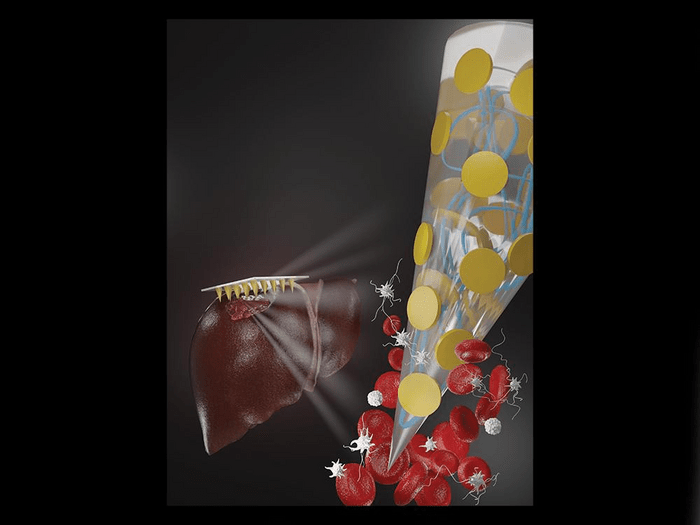UNIVERSITY PARK, Pa. — A soldier suffers a serious gunshot wound on a remote battlefield or a machinist has a work accident and gets stuck in traffic on the way to the hospital. Secondary, uncontrolled bleeding from traumatic injury is the leading cause of death of Americans from ages one to 46.
Amir Sheikhi, assistant professor of chemical engineering and of biomedical engineering at Penn State, has a plan to change that with a novel microneedle patch that can immediately stop bleeding after injury.
He laid out his prototype in a new paper that will be published in the May issue of Bioactive Materials, available now online. The work will be featured on the journal’s cover.
“Excessive bleeding is a serious challenge for human health,” Sheikhi said. “With hemorrhaging injuries, it is often the loss of blood — not the injury itself — that causes death. There is an unmet medical need for ready-to-use biomaterials that promote rapid blood coagulation.”
The hemostatic microneedle technology developed by Sheikhi can be applied like a typical adhesive bandage to quickly stop bleeding. The biocompatible and biodegradable microneedle arrays (MNAs) on the patch increase its surface contact with blood and accelerate the clotting process. The needles also increase the adhesive properties of the patch via mechanical interlocking to promote wound closure.
“In vitro, the engineered MNAs reduced clotting time from 11.5 minutes to 1.3 minutes; and in a rat liver bleeding model, they reduced bleeding by more than 90%,” Sheikhi said. “Those 10 minutes could be the difference between life and death.”
The MNA patch can be compared with the hydrogel technology that is currently used to treat bleeding wounds in hospitals, but hydrogel applications require preparation and medical expertise. The microneedle patch is pre-engineered for immediate application that anyone can use to stop bleeding, Sheikhi said, much like a typical over-the-counter adhesive bandage.
Microneedles — which are already in use to deliver biologics, such as cells or drugs, through the skin or for cosmetic procedures to stimulate collagen production — are tiny, making their application pain-free, according to Sheikhi.
The researchers are now working to translate the patch from the lab to the market, with plans to further test the technology.
All the animal experiments were carried out after the approval of animal protocol by the UCLA Animal Research Committee. Animal handling procedures were performed following the “Guide for the Care of Laboratory Animals.”
Sheikhi received financial support from the Canadian Institutes of Health Research through a postdoctoral fellowship as well as the startup fund from The Pennsylvania State University.
Sheikhi started this work as a postdoctoral scholar at the University of California, Los Angeles, in the lab of Ali Khademhosseini, now the chief executive officer of Terasaki Institute for Biomedical Innovation (TIBI). Other UCLA contributors include Reihaneh Haghniaz, Hossein Montazerian, Avijit Baidya, Maryam Tavafoghi and Yi Chen. Han-Jun Kim, Yangzhi Zhu and Solmaz Karamikamkar, all formerly with the Khademhosseini Lab and now all affiliated with TIBI, also contributed.
Journal
Bioactive Materials
DOI
10.1016/j.bioactmat.2022.08.017
Method of Research
Experimental study
Subject of Research
Animals
Article Title
Tissue adhesive hemostatic microneedle arrays for rapid hemorrhage treatment
Article Publication Date
1-May-2023

















